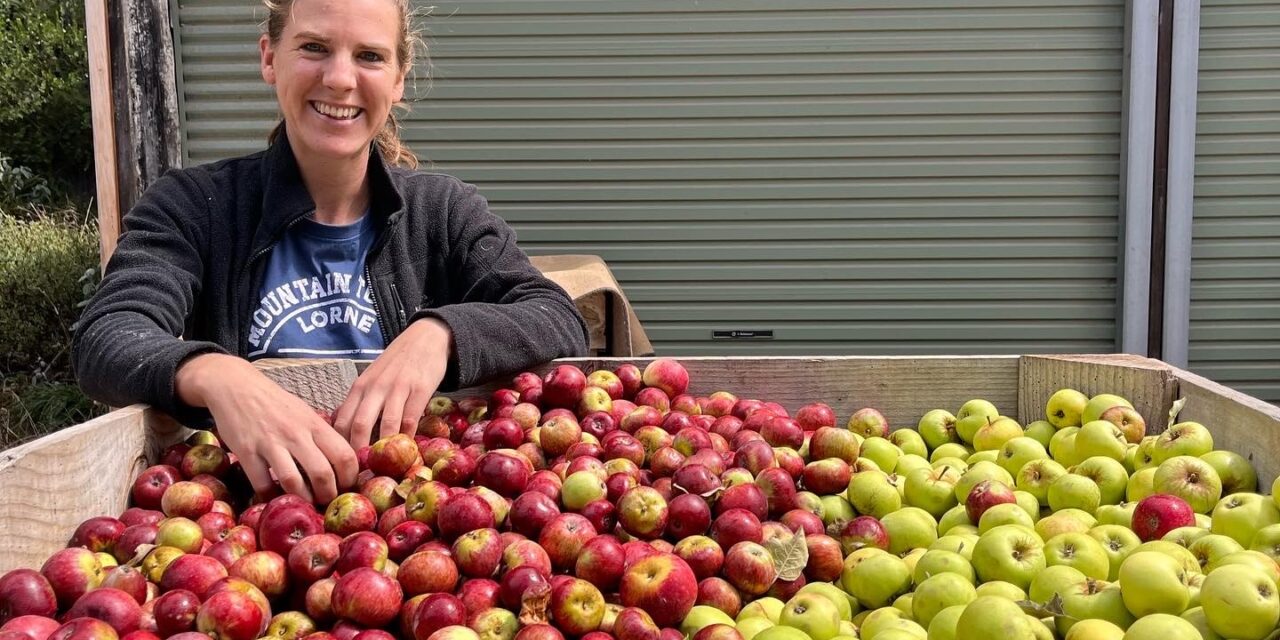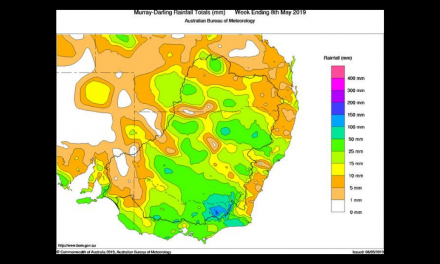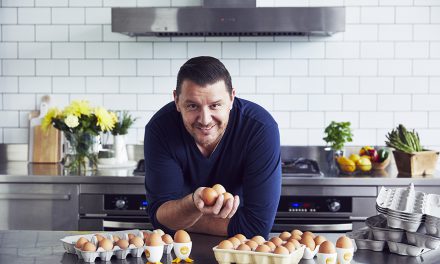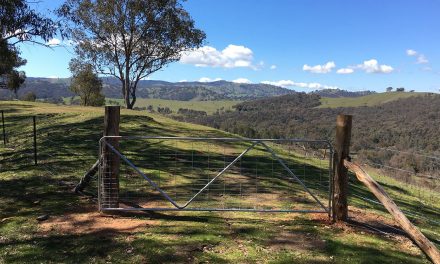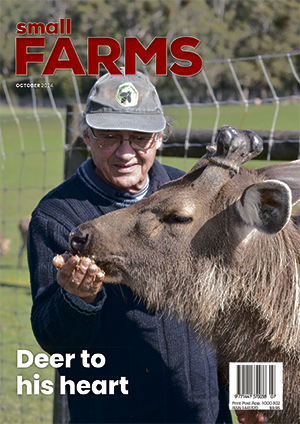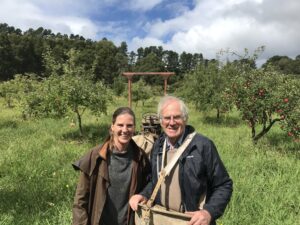
Just about every apple is perfect — for something. With the supermarkets and their predilection for perfection, that leaves a lot of the slightly misshapen, slightly off colour, slightly off the tree too early (ending up on the ground) or just too little or too late to make the contract grade. And then there is the purpose bred apple, the one grown from specialist cultivars, for a very special purpose, as ANDREW MOLE discovered.
If you put a boffin and a boss together, do you get a boofhead?
It’s a crossbreed worth considering — if some geneticist doesn’t get to it shortly, AI most certainly will.
But nestled in the bucolic bliss of the Mornington Peninsula and its gallery of green wedges, vineyards, orchards and trendy trellises of hops and such, is what, at first glance, appears to be another old stock apple orchard.
Which is actually the field laboratory of Camilla Humphries, the boss of Camilla’s Crush – a cidery with a certain je ne sais quoi when it comes to the future of the fledgling industry in Australia.
Camilla also happens to be a Bachelor of Agricultural Science, a Master of Agricultural Science, a PhD candidate — and a Churchill fellow.
Hang on a minute, just hang on!
A boss.
A boffin.
Weren’t we just talking about that? Yes, we were. Absolutely.
But Camilla is a little too special to be in the boofhead category because these days she is pretty damn busy as Camilla the Crusader — a one woman army looking to conquer the country’s apple orchards and set the scene for a cider revolution with which to conquer the world (markets).
A crusade which has already taken her around the world to amass data, data and more data on how the ancient, the traditional and the cutting edge of the current cider wave sweeping through the sea of beverages.
Her Churchill Fellowship saw her head for the UK and Herefordshire, Gloucestershire, and Somerset, before she slipped onto the continent via the Iberian Peninsula, taking in Spain’s Asturias and Basque country, then ducking across the Pyrenees into France and turning north to Normandy and Brittany.
From there it was trans-Atlantic time to New York State and back across the world to New Zealand (Hawke’s Bay and Nelson) before a home tour to show domestic producers the path to cider cultivars instead of run-of-the-mill eating apples, and to better understand different orchard growing systems for cider production to increase efficiency and lower costs of production.
“As an agricultural scientist, commercial cider producer and a committee member of Cider Australia, with experience as an advisor for the Australian apple and pear industry, I believe there is great potential to collaborate with all industry stakeholders to make growing fruit more profitable and available for cider production and thereby grow the Australian craft cider industry,” Camilla said.
“Cider is defined as a fruit wine made from fermented, or partially fermented apple and pear juice, but the Australia New Zealand Food Standards Code (Standard 2.7.3) allows it to contain unlimited water, sugar, and other ingredients,” she said.
“Cider Australia’s definition of an ‘Australian craft cider’ is it must be made from 100 per cent Australian grown fruit, whether juice concentrate or fresh fruit.”
The Australian cider market has been growing for the past decade, now accounting for about four per cent of total alcohol consumed in the Australian market.
Camilla said most of that has been entry level ciders, made from imported juice concentrate and accounting for 82 per cent of all cider produced, while only 10 per cent is craft cider.
She said local and global markets were beginning to see a shift towards premium styles of cider, where provenance and ingredients are becoming central to success.
Supported in no small part by Cider Australia’s development of its 100 per cent Aussie grown, to help consumers make an informed choice.
“For me the opportunity for a seamless transition to cider has already been set up — every day there is so much Australian fruit being wasted, simply because it does not meet supermarket specifications,” Camilla said.
“In a regional grower’s survey I conducted in 2020, there was great interest to develop opportunities for utilising second grade fruit and waste streams through value adding product for cider production.
“The ‘low hanging fruit’ invariably does not get harvested because high labour costs are unjustifiable for anything sold below the cost of production.
“Not only are there opportunities for Australian apple growers to value-add fresh fruit, they can also diversify and grow specific cider varieties.”
Camilla said these cider varieties, compared to culinary apples, contained phenolic compounds providing tannin, contributing to the organoleptic profile or quality characteristics of cider including aroma, flavour, texture and colour.
She said in other developing cider markets she had visited around the world; cider cultivars were starting to provide higher returns to growers than commodity culinary fruit.
Through my work with the Churchill Fellowship, my aims are to:
– Promote provenance and increase the value of Australian craft cider to consumers.
– Provide a value proposition to Australian apple growers to diversify and grow cider cultivars.
– Better understand different orchard growing systems for cider production to increase efficiency and lower the cost of production.
“To support growth in the Australian cider industry, the horticultural industry needs to be able to provide an increasingly diverse variety of fruit in commercial quantities to be a worthwhile investment,” Camilla said.
“Given the fragmented nature of the apple growing and cider making industries, there is a need to compare fruit needs of cider makers with fruit availability in Australian orchards.
“This will involve further work in understanding the value chain to inform and align the industry with the consumer.”
Meanwhile, back on the Mornington Peninsula, Camilla still has all those grassroots demands with which to deal — and the occasional hiccups.
With trees as old as 50 (and plenty aged three to 10) there is an emphasis on Jonathans (a high acid variety) and Cox’s Orange Pippin, an aromatic foil, but also a range of old English and French varieties — along with Camilla’s latest cider cultivars.
While new trees will technically bear fruit in their first year, much of their energy in the first three goes into building their canopy, and Camilla has gone into overdrive with new plantings, particularly Kingston Black, a good bitter-sharp single variety pollinated by Improved Foxwhelp and other varieties which provide the sensory profile of a well-rounded drink including Dabinett, Yarlington Mill, Brown Snout, Michelin and Bulmers Norman.
But she is not the only one with an extra gear.
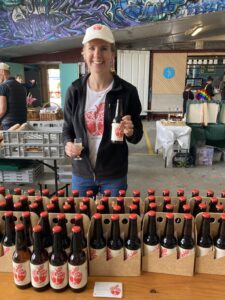
For example, last year an army of rainbow lorikeets, fleeing the Queensland floods, descended on the Mornington Peninsula in general, and Camilla’s Crush in particular, stripping the trees faster than a harvester on steroids.
“The commercial growers are all netted, but the English country orchard, with six feet between trees, is a different proposition and netting would be an incredible expense,” Camilla said.
“Then there are the wallabies, they’ll ringbark and break the tops of the young trees — we have put electric fences around our newest trees but on top of the damage, this year we didn’t get much fruit as apple trees are biennial — meaning every second year they set more fruit.
“In my first year I did yeast trials and have been using a particular Saccharomyces for the past five years.
“Always experimenting with different methods of production — I started force carbonation but now do secondary fermentation in the bottle to create the finer bubble, such as you get in champagne to achieve good effervescence which also lift the flavour.
“I will also be trialling other styles inspired from my travels across the cider lands.
“After a wine making internship in California, coming home I thought of making cider from our apples,” Camilla said.
“My architect father, Chris, who bought the property 50 years ago, has been a great supporter of my cider project, and he built me a cidery and cider lab in his existing work shed at the orchard.”
“With that wine background I make cider like wine, fermenting right through to dryness (no residual sugar), rather the flavour is in the apple, then filtration, followed by a secondary ferment in the bottle to provide a fine effervescence
“In recent years my cider has been made from culinary fruit including high acid varieties such as Gravensteins and Jonathans, combined with my favourite dessert apple Cox’s Orange Pippin which provides good aromatics to balance the high acid. I now grow cider cultivars including: Kingston Black, Yarlington Mill, Improved Foxwhelp, Dabinett, Brown Snout, Michelin and Bulmers Norman but when I had a poor biennial crop a couple of years ago, I relied on neighbours to help out with extra cider cultivars.
“My goal is to continue to educate the consumer about cider and how it can be as complex in flavour as wine when using different cultivars.
“The apple is the champion of the drink and I want consumers to appreciate this when they buy a cider, check the label for the ingredients.
“My cider is made from 100 per cent fresh fruit, in fact, on average there are eight apples in every 330ml bottle of my cider.
“My cider making style is evolving and my Churchill tour through the UK, Europe, the US and New Zealand, will certainly have an influence on the type of ciders I make in the future.”
A future which will embrace Camilla’s diverse background, which has seen her working as everything from a consultant with a Georgian government tour studying irrigation across SA and Victoria to applied research at the CSIRO plant industry division, field research and evaluation of new agricultural protection and nutritional products for the private sector, and international travel to understand agricultural production systems in South America and Europe.
Above all, Camilla says she gets a lot of satisfaction engaging with growers and implementing research “to contribute to a more economically viable and environmentally sustainable industry”.
With apples obviously the nearest and dearest to her heart she sees a lot of that revolving around work with other apple growers, fruit processors and cider makers to provide ideas on how both industries can work collaboratively, and convince smaller commercial growers to diversify their businesses to grow fruit for juice and a bigger and better cider industry.
And in Camilla’s world, that would see her own production grow way beyond its current 500 litres, while the cider craft industry will see its market share soar to 30 per cent.
Never hurts to aim high.
FOOTNOTE: Never one to let the grass grow under her feet, in her spare time Camilla has also been a co-founder of the Red Hill Cider Show and, in 2022, she entered a dry cider made using traditional cider cultivars and made in the traditional way (secondary fermentation rather than force carbonation) and walked away as a bronze medallist in the International Australian Cider Awards.

